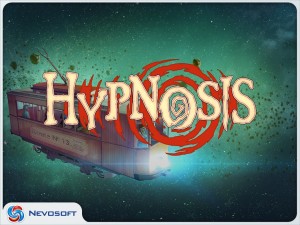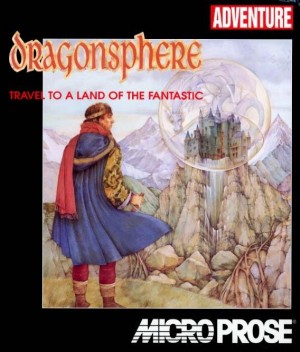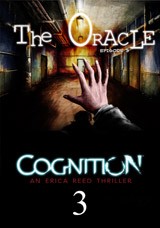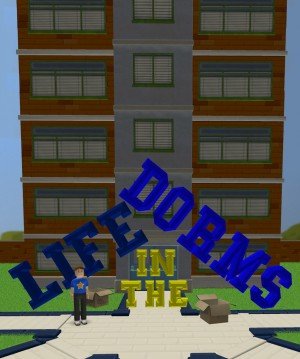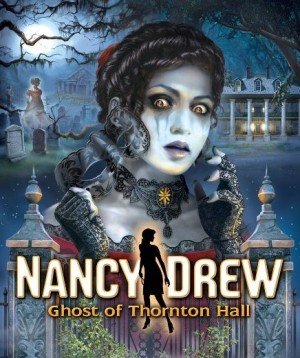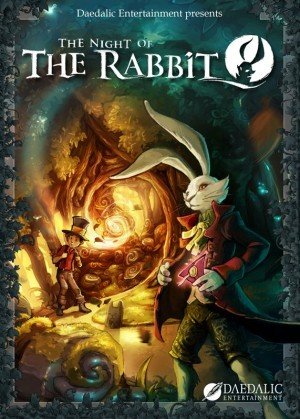Review for Nightmare Adventures: The Witch’s Prison
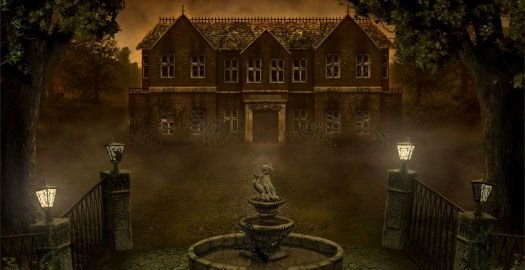
Looking for a good scare? Or maybe a good laugh? How about an insane amount of puzzles? If you’re up for all three, look no further than the two casual Nightmare Adventures games from Ghost Ship Studios, The Witch’s Prison and The Turning Thorn. Though both are held back by simplistic graphics and animations and jumbled storylines, a large variety of engaging puzzles and copious amounts of exploration and witty observations make this lite adventure series worth checking out.
If you’re a lucky descendant of wealthy ancestors, you’ll maybe receive a nice sum of money or a stately mansion as an inheritance. Kiera Vale has no such good fortune. Her relatives left her an asylum. An old one that’s been quarantined. In The Witch's Prison, Ms. Vale’s discoveries about this abandoned, and apparently haunted, asylum take players on an entertaining puzzle-filled adventure filled with as many jokes as spooks as you investigate the old institution, unlocking ancient family secrets along the way. However, Vale unwittingly releases an ancient terror that you then need to help imprison in The Turning Thorn. In the sequel, Vale is asked to enter the minds of various people as she tries to track down a monster.
The story in both games is told through flashbacks. When you first meet her, Ms. Vale is being interviewed in static comic book-style cutscenes by paranormal investigators who are part of the A.R.C.A.N.E organization. They want to know what she knows about Blackwater Asylum. As Vale begins to tell her story, you’ll begin the game proper by visiting memories that take her back to her initial explorations of the facility.
As if the crumbling structure’s decrepit façade wasn’t inviting enough, you're immediately met with a quarantine sign put up decades ago by the Boston Metro health district during an influenza outbreak. Wonderful. It’s not enough to turn the protagonist back, however. Vale’s looking for her birth mother, and the letter that brought her to the asylum indicates that her real family name is Wystwick. As she breaks through the layers of history crusting over the asylum, she learns more than she ever wanted to about her family.
In the first game, the cutscenes relating this tale are silent and static. The story is muddled (there are so many Wystwicks, so many riddles and puzzles about the family), and these cutscenes didn’t do much to clarify the details for me. Often it wasn’t until I went back over the journal notes that you receive in your smartphone that pieces of the story actually fit together and made sense... well, mostly. The second game uses similar cutscenes, with the inclusion of a nice voiceover adding a bit of life to these story fillers. The sequel's voice acting for Vale is solid as you help her explore A.R.C.A.N.E.’s research base.
There are a variety of ambient sounds adding depth to your explorations. The high-pitched call of crickets and low moan of wolf howls greet you as you explore the lawn in front of a groundskeeper’s home. Weaving around these environmental sounds is off-kilter music filled with oboes and strings. However, there are long periods of time with no music at all. Too much music is overkill, but not enough and you’ll feel like you’re walking through a vacuum, and here I often found myself wandering the grounds in total silence. What tunes the games do have can sometimes be quite haunting, such as a lovely, lonely piano piece in a minor key. The sound work in the second game is similar. In one scene, you’ll come across an old woman hunched over a desk with her back turned to you. She doesn’t turn when you enter; she stays silent, writing, and the scritch-scratching noises of her scribblings adds a sense of unease as you probe the room around her. At several points in both games, the sudden intrusions of harsh whispers in the silence caused me to jump abruptly.
You'll come in contact with a few, um, interesting characters. Alton Quinn is the crusty groundskeeper at Blackwater Asylum. Quinn is a "character" with a capital C. He had been perusing Vale’s forum postings and found out that she was interested in the Wystwick name. It was Quinn who sent Kiera the letter that brought her to the asylum, and he’s got a picture of Vale in his abode. He watches a TV showed called "The Cat Psychic". He’s got a human skull in his bedroom. And he buries animatronic cats. Creepy. Alton is, bizarrely, the only character you learn this level of detail about in the first game, and that includes Vale. Oh, you’ll learn about the various Wystwicks and their asylum shenanigans, but you learn all of this through journal notes, riddles, and snippets of paranormal investigation notes, which makes for a rather two-dimensional feel to all of the other characters referenced in the game.
You’ll also meet the mysterious cult investigators of A.R.C.A.N.E., though more so in the second game. In The Turning Thorn, Jillian, the head of bioresearch, seems normal enough – just don’t ask her how she broke her arm. You’ll also enter the mind of a security agent, Gomez, but you enter her childhood rather than her adult memories, wandering through a treehouse and exploring her inexplicably locked-up toys. There is also an odd child in the lab who continually howls for her pig – she’s a screecher, but she promises she won’t bite. The sequel finally reveals a lot more about Vale. She’s a bit of an academic and a lover of all things Egyptian, a background that helps her out in some instances (though it's not that helpful in others).
In both adventures, Kiera encounters a series of obstacle-filled environments that require inventory and logic puzzle-solving to get through. An initial puzzle in The Witch’s Prison has you searching for not-so-subtly hidden gears scattered around the gate to the asylum. Well, it turns out that coincidentally enough, the gate’s opening mechanism is missing gears. Vale even comments on the obviousness of some of the locks: “The screw holding the lock comes off easily. Real secure guys.” Your inventory searches yield intuitive items, from screwdrivers to fuses, that you’ll use to break through, start up, or unlock your way through obstacles. But you’ll also find items like lottery tickets strewn about, and, stretching belief, a DNA-testing kit in the first game that just happens to be sitting around.
The backgrounds of both games can be dark, making it difficult at times to see the items you need to pick up, and you’ll find yourself sweeping the screen to find hotspots and items. An additional frustration in both games is that even after certain hotspots are no longer useful, you can still zoom in to look at them again up close, suggesting there is some further interaction available. Pay close attention to everything that you see, no matter how mundane items might seem. A few times that I found myself stuck on inventory puzzles it was because of some small object in another scene that I neglected to pick up. The Turning Thorn adds an extra element to the inventory solutions by allowing you to combine multiple items that you have collected.
The two Nightmare Adventures are very self-aware of the casual sub-genre to which they belong. In fact, in each game you’ll encounter a single mocking hidden object search. In the first, you’ll stumble upon one on a computer that has you searching for unicorns! And bunnies! That is, until your free trial expires. A similar “wink-wink, look at us better than other casuals” game-within-a-game HOG makes an appearance in the sequel in"Unicorn Wedding Mysteries". This sequence features a gate closed with a shoelace, with your in-game character moaning that she’ll never be able to get inside. It’s an amusingly entertaining side trip, but given some of the crazy locks you encounter in the main games, it veers very close to self-parody. But Nightmare Adventures goes to a lot of trouble to explain why there are so many complicated locks that you must navigate throughout the asylum and the research base: The keepers feared the kept in both instances.
There are a variety of secondary storylines running through The Witch’s Prison and The Turning Thorn. Because of the lack of coherence at times, I found it more enjoyable to just watch the various set pieces unfold rather than trying to make sense of the rather silly plot details. At various points you’ll witness macabre tableaus that seemed dreamt up merely to show you gruesome scenarios, like a doll vomiting up a torrent of pins, or a girl driven mad enough to pull out all of her hair at the Blackwater Asylum. And try wandering through a paranormal research lab built deep underground and finding yourself locked in a room with a half-open body bag and not be just a teeny bit creeped out.
The slideshow artwork in both games is moody and effective, if a bit technically dated. The attention to detail is highly entertaining. From the cable menu on the groundskeeper’s television that lists shows like “Dog Swap,” “Dance Party,” and “Scream Time With Mr. Creeps,” to the Super Jackpot Mega Millions lottery tickets Quinn has strewn about his house, to the advertising image of a shark jumping out of bloody waves on a can of Diet Cherry Chum, the details in the photorealistic artwork add a nice layer of interest to each scene. The simple animations mean that if you’re looking for whiz-bang eye candy, however, neither game is for you.
I found the bountiful observations you receive when you click around to be just as interesting. Kiera stumbles upon a horoscope, or rather a horrorscope, with the following fortune: “The path ahead is fraught with danger and will cause your hair to gray prematurely . . . old friends will return . . . possibly from the grave… your luck is about to change … for the worse, so avoid games of chance, carnival rides, and petting zoos.” Vale will look at an oven mitt and mirror your own thoughts (even though you picked it up hoping it would be useful) by sarcastically noting: “An oven mitt; now I’m ready for anything.” Things that may seem like throwaway details, like a dumpster filled with mostly broccoli (that’s just weird), or a cup from Bucket O’ Tacos (yuck), or that bottle of Diet Cherry Chum (“It’s bloody refreshing”) will make sense later in the game.
From a secret laboratory where mysterious experiments were being conducted on “samples” from Blackwater Asylum and paranormal labs once filled with overcaffeinated scientists in The Witch’s Prison to alien worlds and strange catacombs with piles of skulls and molten lava and fire in The Turning Thorn, you’ll find an abundance of fun areas to explore. I found a desolate world with strange towers, pale pink, shrouded in moving clouds and three pale suns to be serenely beautiful. Does it make sense? Well, no. But it's beautiful. Both games provide a ton of exploration; so much, in fact, they really could have done with a nice map.
Along the way, you’ll find the abundance of logic puzzles to be a strength for both games, from simple jigsaws to word problems (urgh), basic slider puzzles, rotating pipes, anagrams, and – well, you get the picture. Need safety scissors from the children’s area? You’ll have to play through a dollhouse puzzle to get them. And a turn-the-pipe puzzle isn’t just a turn-the-pipe puzzle; you’ll not only need to connect the pipes, you’ll also need to get the right voltages displaying across the pipes in order to solve it.
You’ll encounter no shortage of rhymes that will serve as clues that help to make these puzzles fun to play through. They are also skippable, which you may not need for the easier puzzles as there is also a hint system that gives you nicely layered tips. Just as helpfully, your camera can take photos that will give you portable hints. There isn’t any trick to taking photos; whenever you come across a scene with clues, your camera will automatically record the picture for you. These photos are stored separately from the rest of your inventory for easy access. Even so, make sure to take notes, whether it’s to help you decode messages or align items. I found myself filling up pages of notes to help me solve many of the elaborate locking puzzles and obstacles. The difficulty level appeared to be a bit turned up in the second game.
There are some scares and creepiness in spades, for sure, and yet at times both games lean more toward a comic tone. In The Witch’s Prison, you explore a darkened room, sweeping your mouse/flashlight around before stumbling upon a woodcut of a witch burning and unearthing further backstory of the asylum and its patients. And yet it quickly eschews the spooky asylum background to delve into the lives of the scientists who somehow managed to get their computers haunted. The second game is no less bizarre. TV plays a pivotal part, with an infomercial for a Magic Amulet™ that’s so connected that the second you decide to order it, the doorbell rings. The sequel starts with you mind-melding with the witch and later has you going into the minds of different characters, including security folks that pack heat but like fluffy bunnies. Don’t let these funny asides fool you, though. This isn’t all unicorns and fuzzy woodland animals. You’ll come across corpses in body bags, melting people, and deranged witches. So do you laugh? Scream? I did both, and if I didn’t pay too much attention to the storylines, I had a great time.
Clocking in at more than four hours of play time each, the two games wrap up their individual tales but leave the stories wide open for a continuation. If you skip the first game for some reason, you’ll come across a journal and a camera with shots from your previous outing that will helpfully bring you up to speed on the haunted events in the second episode. It's worth starting right from the beginning, however, as both The Witch’s Prison and The Turning Thorn live up to their series moniker: these aren’t just nightmare tales that will spook you; with their many witty observations and fun puzzling, you’ll also have a grand adventure throughout.
WHERE CAN I DOWNLOAD Nightmare Adventures: The Witch’s Prison
Nightmare Adventures: The Witch’s Prison is available at:
We get a small commission from any game you buy through these links (except Steam).Our Verdict:
If you embrace the silly side in between the scares, both Nightmare Adventures offer a fun, puzzle-filled romp through a tale about twisted family bloodlines and paranormal exploration.













